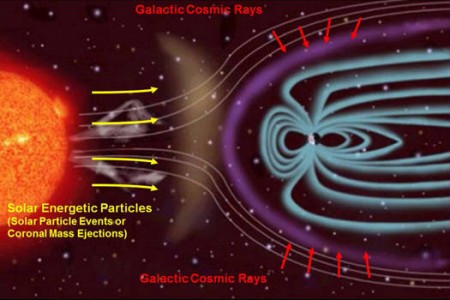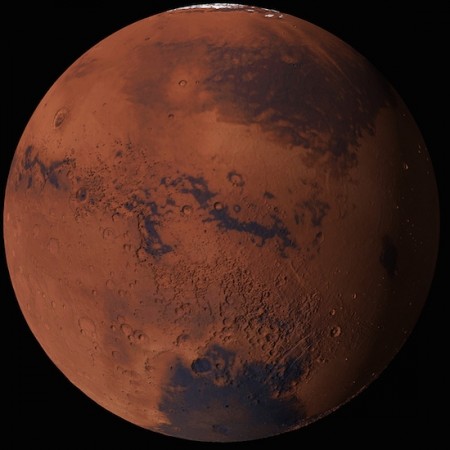May 4, 2015 – Should this be a surprise to anyone who has studied radiation and its impact on living things? Conventional propulsion and shielding technologies will not cut it on a six-month voyage through Deep Space to Mars. Research at the University of California, funded by NASA, clearly shows that mice subjected to equivalent levels of the type of radiation astronauts would encounter develop acute brain inflammation leading to cognitive impairment. The study appears in Science Advances and is entitled, What happens to your brain on the way to Mars.
All of our human spaceflight history, with the exception of the Apollo landings on the Moon, has been in near-Earth orbit. In truth although we describe these missions as taking place in Outer Space, they are really happening on the outer edge of our atmosphere. As illustration, the International Space Station, orbiting at 415 kilometers (258 miles) needs an occasional boost from on board engines to maintain its position because the tenuous presence of the atmosphere at that height creates enough drag to pull the space habitat downward. Left on its own its orbit would degrade and the space station would burn up in the atmosphere.
That atmosphere and Earth’s magnetic field today are our shield making near-Earth space a comparative Eden to the world of Deep Space where cosmic rays and solar radiation represent a lethal combination to an unshielded spacecraft containing living occupants. And even on the space station when there is an occasional solar flare astronauts today use on board polyethylene radiation shielding to protect them. The aluminum walls of the station provide little if any shielding.
The problem of radiation and its human impact is the primary reason I seriously question Mars One with its reliance on existing technology to place human colonists on the Red Planet within the next decade. Even the future planned NASA asteroid mission that would bring astronauts to a space rock parked in lunar orbit is intended to be 24 to 25 days in duration using the Orion spacecraft. Mars One, on the other hand, is a six-month journey. A mission to lunar orbit is a mission to Deep Space. A mission like Mars One is Deep Space times nine.
Orion, NASA’s first Deep Space spacecraft post Apollo, is currently the only vehicle intended to go to Deep Space. SpaceX and others may eventually come up with modules intended for similar missions. But for now Orion is alone and its first test flight, an unmanned launch in 2017, is intended to measure just how much exposure to radiation future astronauts will encounter. NASA’s description of the methods it intends to deploy on Orion to protect astronauts from ionizing radiation include “a temporary shelter in the aft bay of the spacecraft…the inside portion closest to the heat shield” and using “the supplies, equipment and launch and re-entry seats, as well as water and food” on board to provide additional shielding. If I were an astronaut I’d seriously question the adequacy of the strategy. And that doesn’t deal with astronauts relying on a next generation of spacesuits for extravehicular walks in Deep Space. How much shielding can you put into a spacesuit?
Before this study NASA documents talked about the effects of galactic cosmic, trapped, solar energetic particles and ultraviolet radiation on human crews. They described both acute and chronic medical issues including in the acute, nausea, vomiting, fatigue, and central nervous system diseases, and in the chronic, cancer, cataracts, other vision impairment and degenerative cardiac diseases.
Now add to this “performance decrements, memory deficits…loss of awareness and focus during spaceflight.” The worst of the damage in mice occurred in the medial pre-frontal cortex and hippocampus. In humans this cognitive impairment would make it hard for astronauts to understand complex problems or deal with unexpected events.
NASA and other spacefaring nations and programs know that radiation is the show stopper when it comes to human spaceflight. If we cannot solve this challenge we will remain planet bound and only our virtual presence will go to Deep Space because robotic missions like the one that delivered Curiosity to Mars can handle radiation that we cannot. So the minds at NASA and other space agencies are looking at different solutions including:
- Building propulsion technologies (solar electric, pulsed nuclear, etc.) that shorten the length of the voyage whether to an asteroid or Mars.
- Designing new exterior shielding technology (Bigelow inflatable habitats) that don’t add significantly to payload weight requiring much greater thrust to get from the gravity well that is Earth to near-Earth orbit.
- Or coming up with a new generation of drugs that counteract radiation exposure and protect future Deep Space voyagers from induced cognitive impairment.


















It all boils down to the increasingly obvious proposition that without strong AI robots mankind will be perpetually earthbound. Don’t waste resources on rockets and spacestations; invest in AI. If smart robots cannot “prepare a place before us,” space has no place for us.
During the last 12-months, however, there has been encouraging news for the space romancers. IBM’s announcement of the neuro-synaptic chip and HP’s recent announcement of the memrister circuit technologies (covered on this site) promise that Moores’s Law as commonly misunderstood is not only on track, but will be picking up speed as it races into the 2030s. Kurzweil might prove to have been too conservative in his estimate that cheap electronic brains will reach human-level intelligence/consciousness in 2030; It could happen by 2025. It will almost certainly happen by 2030. The universal genius-level-robot for less than $50,000 should be available by 2035. Walmart is probably already looking into replacing its human store dolts with smarter robots.
Smart robots could run a space program that boosts a pound of payload into a stable 300-mile Earth orbit for $50. Then it would be feasible for robots in space to build giant artificial gravity and well-shielded wheel-habitats for humans. Then humans could live indefinitely in space without radiation damage to their brains. But critical pundits might say that only humans who already have brain-damage would want to leave the Paradise of Earth served by robots and go live in the wheel ships cruising toward nowhere through the endless void of space. On the other hand, maybe incorrigible criminals might prefer life on the wheel ships to prompt execution on Earth.